When shopping for a new HVAC system or upgrading your home’s heating and cooling, you may have come across the term SEER or SEER2. SEER stands for Seasonal Energy Efficiency Ratio, a crucial metric that measures the energy efficiency of an air conditioning or heat pump system. Understanding SEER and SEER2 ratings can help you make an informed decision, saving money on energy bills while reducing environmental impact. In this guide, we’ll break down everything you need to know about SEER and SEER2, how they differ, and why these ratings matter for your HVAC system.
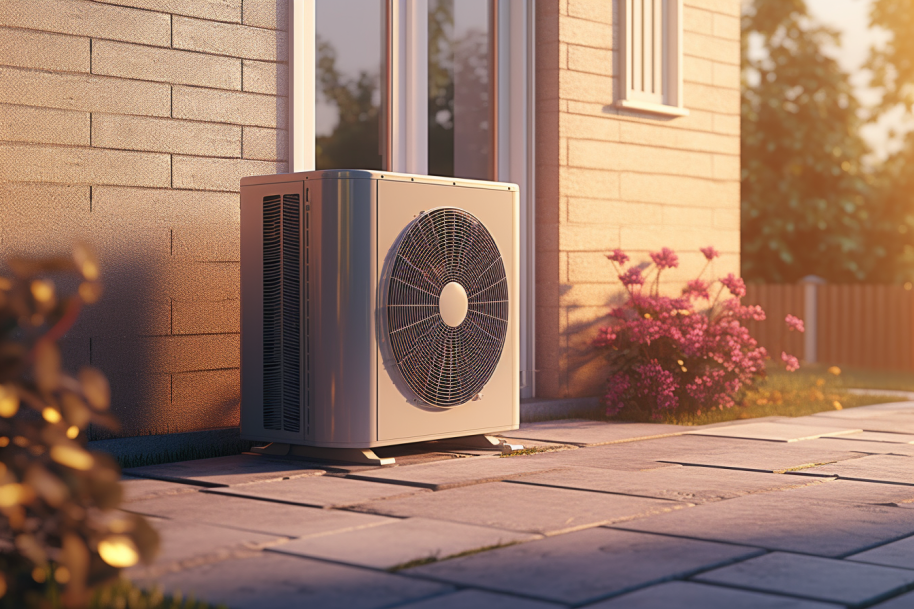
What Does SEER Stand For in HVAC Systems?
SEER, or Seasonal Energy Efficiency Ratio, is a measure of how efficiently an air conditioner or heat pump can cool a space over an entire cooling season. Calculated as the ratio of total cooling output (in BTUs) to the total energy input (in watt-hours) over the same period, a higher SEER rating indicates greater energy efficiency. For example, a system with a SEER rating of 16 is generally more efficient than a system with a SEER rating of 13.
The U.S. Department of Energy has established minimum SEER requirements for HVAC units, which vary by region. Higher SEER ratings are generally required in warmer climates, where cooling needs are more intensive.
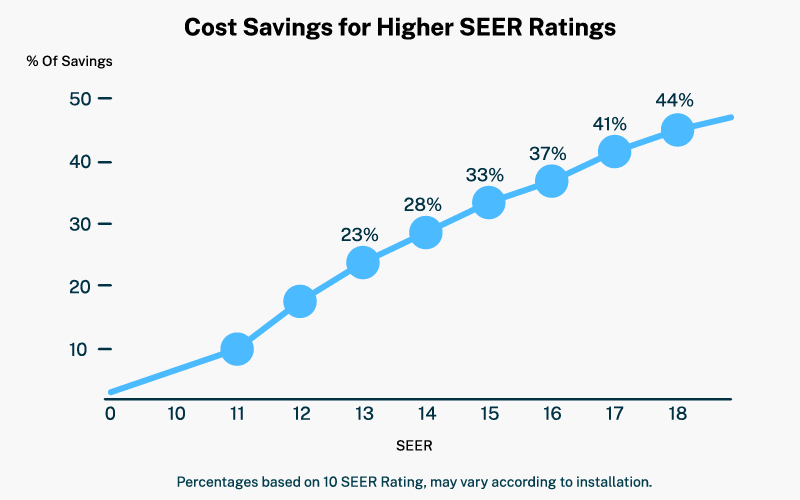
Understanding SEER2: The Next Generation of Efficiency Standards
In recent years, the HVAC industry introduced SEER2, a revised standard that takes a more accurate approach to measuring energy efficiency. SEER2 calculations factor in new testing procedures and improved measurement methods, creating a more precise rating for energy efficiency under real-world conditions. SEER2 is particularly relevant for systems installed after the U.S. Department of Energy’s updated efficiency requirements, which took effect in January 2023.
Learn more about the updated SEER2 standards on the Air-Conditioning, Heating, and Refrigeration Institute’s website.
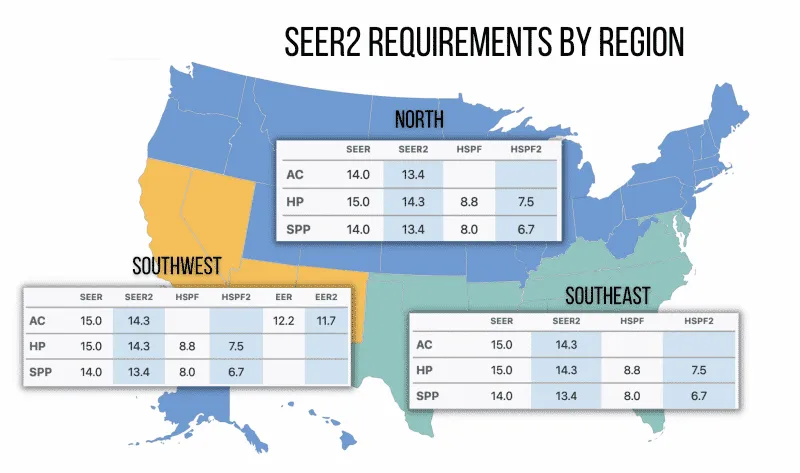
How Are SEER and SEER2 Calculated?
Both SEER and SEER2 are calculated based on the cooling output (in British Thermal Units, or BTUs) and energy consumed (in watt-hours) during the cooling season. Here’s how each one is measured:
SEER Calculation
The SEER rating is the ratio of total cooling output over the cooling season to the total energy consumed in watt-hours. For example, if a unit provides 36,000 BTUs of cooling over a season while consuming 3,000 watt-hours, its SEER rating would be calculated as follows:
SEER = Total Cooling Output (BTUs) ÷ Total Energy Input (Watt-hours)
SEER2 Calculation
SEER2 uses a similar calculation but incorporates updated testing procedures to account for real-world scenarios. This provides a more accurate reflection of the system’s performance under actual usage conditions, which can be affected by duct leakage, static pressure, and other factors. SEER2 ratings are often slightly lower than SEER due to the stricter testing conditions, but they offer a more realistic efficiency assessment.
Why SEER and SEER2 Ratings Matter for Energy Efficiency and Cost Savings
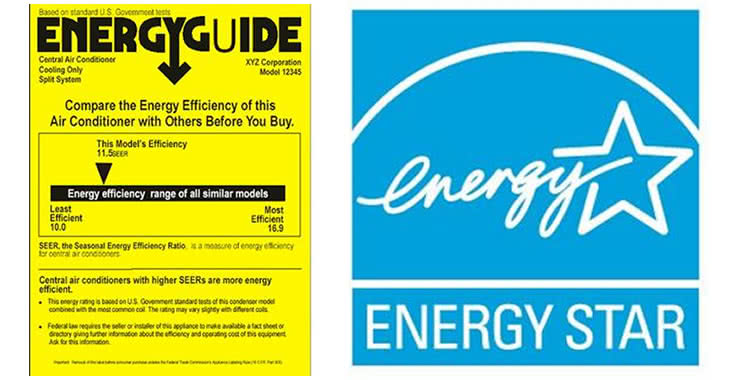
Higher SEER and SEER2 ratings translate to greater energy efficiency, which can lead to substantial cost savings over the lifespan of an HVAC system. A higher SEER rating reduces the system’s energy consumption, ultimately lowering your monthly electricity bills. For example, upgrading from a SEER 13 to a SEER 16 system can save homeowners up to 30% on cooling costs during the summer months.
Additionally, high-SEER systems are generally designed with advanced technology, such as variable-speed compressors and enhanced cooling controls. These features not only improve efficiency but also enhance overall comfort by providing more consistent temperatures and better humidity control.
Comparing SEER vs. SEER2: Key Differences
While SEER and SEER2 both measure energy efficiency, SEER2 is considered a more accurate standard because of its improved testing procedures. Here are some key differences between the two:
| Factor | SEER | SEER2 |
|---|---|---|
| Calculation Method | Based on ideal testing conditions without duct or pressure variations. | Includes real-world testing factors, such as static pressure and duct leakage. |
| Rating Scale | Ranges from 13 to 24+ | Slightly lower than SEER due to stricter testing standards. |
| Accuracy | Idealized efficiency measurement. | More accurate for actual usage conditions. |
Minimum SEER/SEER2 Requirements in the United States
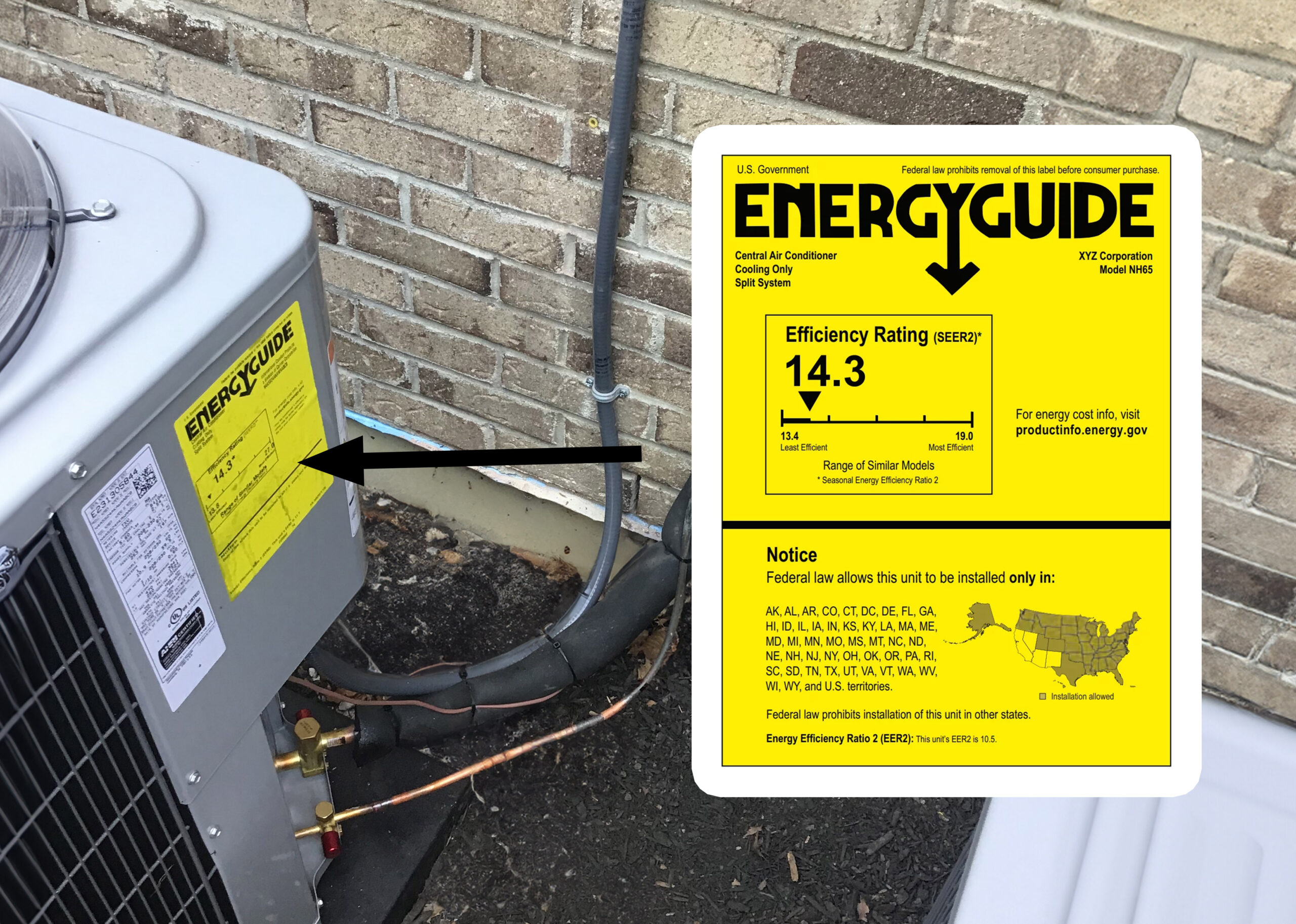
Minimum SEER and SEER2 requirements for new HVAC systems vary by region due to different climate demands. Warmer regions, such as the southern United States, have higher SEER minimums to ensure efficient cooling. These minimums are regulated by the Department of Energy to promote energy efficiency and reduce environmental impact.
Current Minimum SEER Requirements:
- Southern States: 15 SEER or higher
- Northern States: 14 SEER or higher
For SEER2 ratings, updated guidelines took effect in 2023, with similar regional requirements but adjusted calculations to reflect real-world efficiency.
How to Choose the Right SEER/SEER2 Rating for Your HVAC System
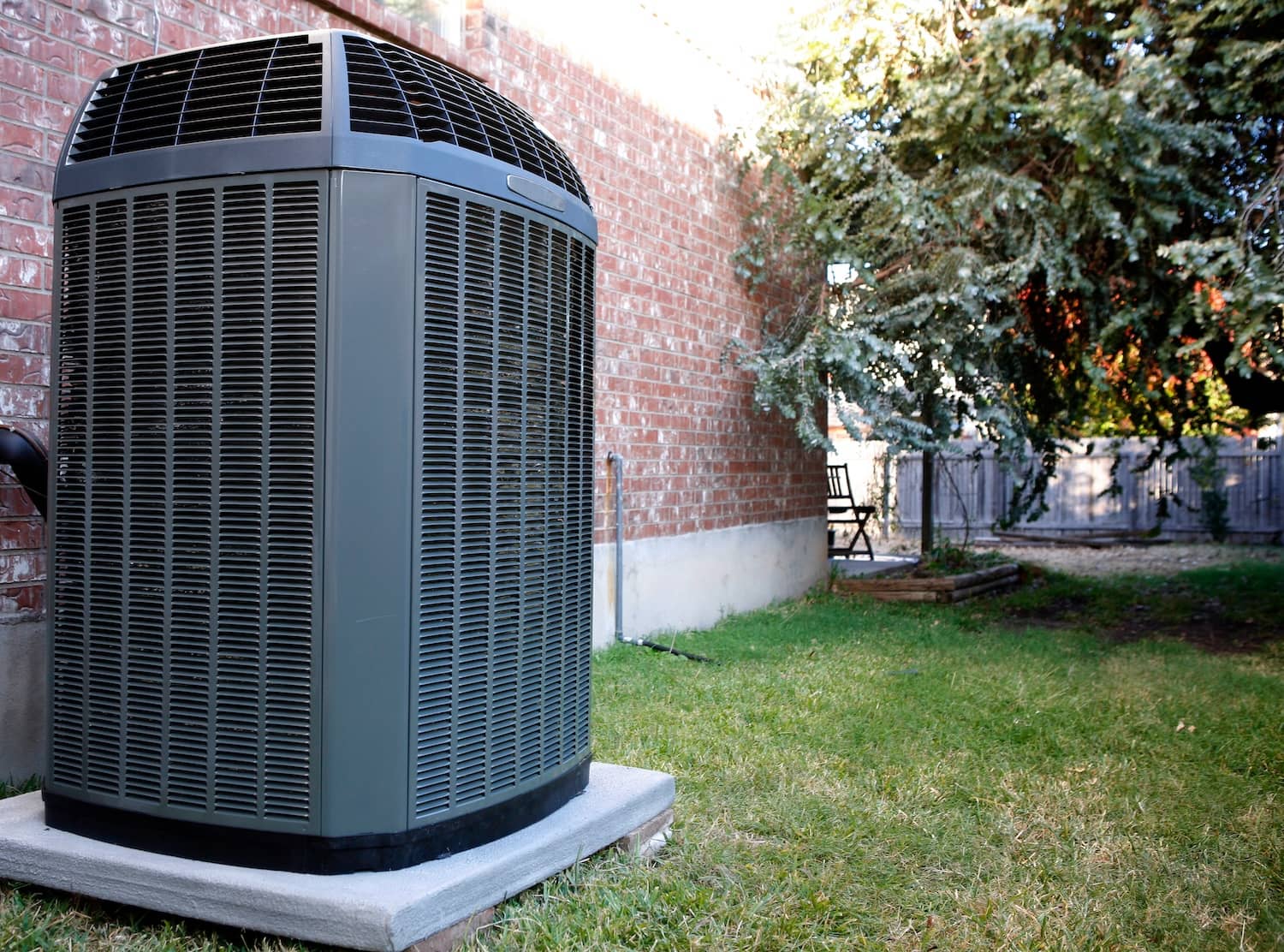
When choosing an HVAC system, consider both the SEER/SEER2 rating and the initial cost of the unit. High-SEER systems are more energy-efficient, but they also tend to have a higher upfront cost. Here are some factors to consider:
1. Climate and Location
If you live in a warmer climate where air conditioning runs frequently, investing in a high-SEER system (16 SEER or higher) may lead to significant savings. In milder climates, a lower SEER rating may be sufficient, and the savings on energy bills may not justify the higher cost of a high-SEER unit.
2. Energy Efficiency Goals
Homeowners focused on reducing their environmental impact or achieving ENERGY STAR® certification for their home may prioritize high-SEER systems. Many high-efficiency units meet ENERGY STAR standards, contributing to reduced energy consumption and greenhouse gas emissions.
3. Budget and Payback Period
High-SEER systems come with a higher price tag, so it’s important to weigh the upfront cost against potential energy savings. A SEER rating calculator or HVAC professional can help estimate payback periods based on your specific usage, energy costs, and the efficiency of the unit you’re considering.
Benefits of High-SEER and SEER2 HVAC Systems
Investing in a high-SEER or SEER2 system offers multiple advantages, including:
- Lower Energy Bills: High-SEER systems consume less electricity, reducing energy bills over the system’s lifespan.
- Increased Comfort: Many high-efficiency units come with variable-speed motors that adjust airflow to maintain a consistent indoor temperature.
- Reduced Environmental Impact: By using less energy, high-SEER systems contribute to lower carbon emissions and environmental impact.
- Potential Rebates: Some states and energy companies offer rebates for installing high-efficiency HVAC systems, making them more affordable.
FAQs: SEER and SEER2 Ratings in HVAC
| Question | Answer |
|---|---|
| What is a good SEER rating for an HVAC system? | A SEER rating of 16 or higher is generally considered good, especially in warmer climates where cooling is used frequently. |
| Is a higher SEER rating always better? | Higher SEER ratings mean better energy efficiency, but they also come with a higher upfront cost. Consider climate, energy savings, and budget. |
| What’s the difference between SEER and SEER2? | SEER2 includes updated testing procedures that account for real-world usage, making it a more accurate efficiency measurement than SEER. |
| Are high-SEER systems eligible for rebates? | Yes, many high-efficiency units qualify for rebates from state programs or energy companies, making them more affordable. |
| Does a high SEER rating affect heating efficiency? | SEER applies only to cooling efficiency. For heating efficiency, consider the HSPF rating if you’re choosing a heat pump. |
Conclusion
Understanding SEER and SEER2 ratings is essential for selecting an HVAC system that meets your energy efficiency and budgetary needs. With higher SEER ratings, homeowners can achieve better energy efficiency, reduced utility bills, and enhanced indoor comfort. However, it’s important to balance the cost of a high-SEER system with potential savings. Consulting with an HVAC professional and considering factors like climate, energy goals, and budget can help you make the best decision for your home. Whether you’re upgrading or installing a new system, SEER and SEER2 ratings are key indicators of the long-term performance and efficiency of your HVAC investment.

